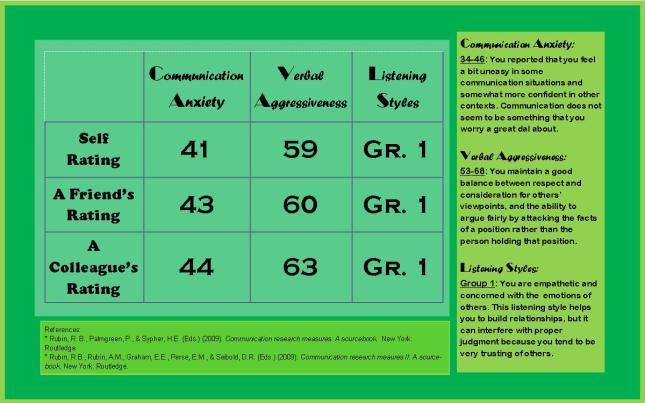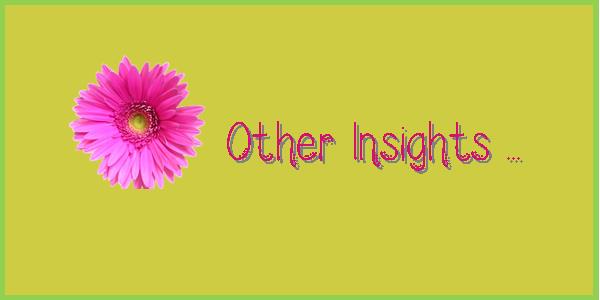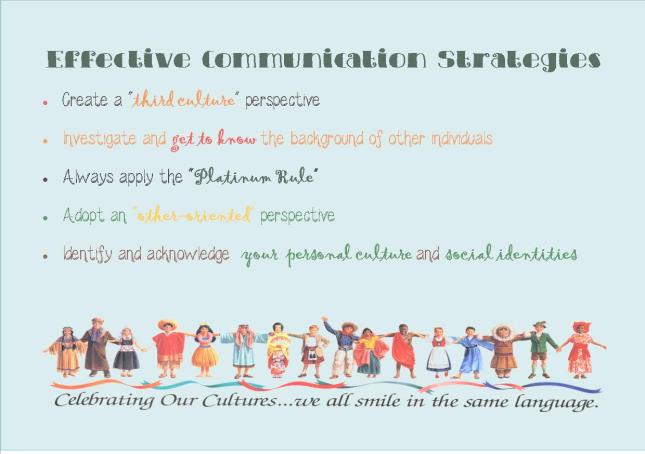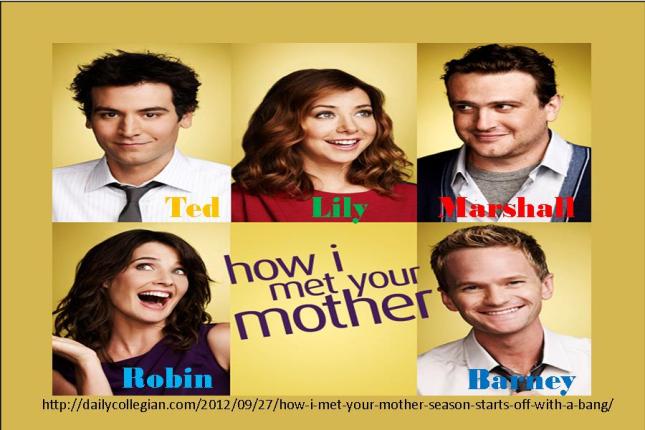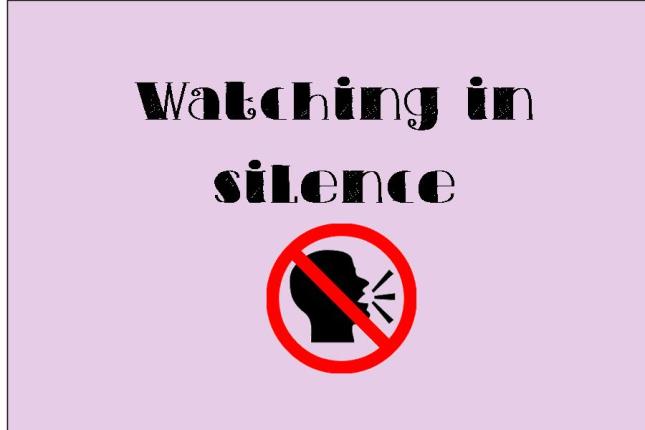This week, we began evaluating how we perceive ourselves as communicators, as well as identifying the similarities and differences between our self-evaluation when compared to how others evaluate us. We took a series of three tests and asked close friends, family, or even perhaps a colleague to take the same test to compare results. When I started to work on these questionnaires, I pondered who I could ask to give me an honest opinion about how I communicate. I was certain that my results would be much different than those of my friends or family, but I still wanted a good picture of how I communicate in different settings, situations, or with different groups of people. Therefore, I settled on Sam, who is a very good friend of mine. Sam and I have known each other for years, and our friendship has grown solid. Since we are so close, I tend to take out my frustrations on him during some of our conversations, so I figured that my verbal aggression would score high according to Sam’s perception. I also decided on Rita, a colleague. Rita and I converse together much differently compared to my family (as I tend to let my mouth run a bit looser in a much more laid back, secular setting). My communication would obviously be different according to her, right? Well, let’s take a look at the results …
Looking at these results, the one thing that surprised me the most was that my communication style and skills remained the same across a variety of situations, settings, and with different groups of people. This shocked me for a various of reasons. For starters, I was pleasantly surprised to find that I rated myself about the same as my friend and colleague did. Since I often deal with low self-esteem, I tend to have an “inconsistent view” (O’Hair & Wiemann, 2012, 49) of myself, which ranges from thinking I’m a good communicator with my colleagues to thinking I am an ineffective communicator with my friends. When I saw these results, my self-esteem was encouraged, as I found out that my communication skills are perceived about the same through my eyes, my friend’s, and my colleague’s.
In addition, I was surprised that Sam rated my verbal aggression moderate, as I tend to raise my voice more with him than any other person. When I am frustrated or upset, I usually end up “blowing up” at him because I know that he can handle me. Knowing this negative trait about myself, I anticipated that Sam would also perceive that as well. Yet, I was startled to discover that he does not consider me as aggressive as I do. Rather, my verbal aggressiveness is moderate, which is almost identical to the results that both my colleague and I had.
Furthermore, when I asked Rita to complete these communication inventories, I was very curious to see how she viewed my communication ability as a professional. Sure, I could figure out how I communicate with my friends and family, but I wanted to know, How do I communicate as a professional? What do my colleagues and families take away after talking to me? I was surprised to find that my communication abilities are perceived just about the same across different situations with different types of people. This surprised me, as I began to realize that perhaps I am more of a competent communicator than I expected.
Looking at these results, I came to the conclusion that I am actually a better communicator than I realize. Since I am perceived about the same in my verbal aggression, listening skills, and communication anxiety from friends and colleagues, my effectiveness in communication is more than likely equivalent in a variety of settings. This encouraged me and helped to boost my self-esteem, challenging me to become an even more effective, competent communicator with everyone I encounter.
Completing these questionnaires, comparing the results with a friend and a colleague, and reading through the learning resources allowed me to gain a number of insights that will ultimately impact my professional work and my personal life. They are as follows:
1. As I learned through my own personal results, an effective communicator will more than likely be perceived about the same across a variety of situations and within different groups of people. I believe that the more reliable and stable one’s communication abilities are, the more he or she will be able to be competent in communication. This insight is important for my professional work through the realization that I need to maintain a consistent set of communication skills with all families and children. If one family perceives that I communicate much differently with them as compared to another family, this may make them question the relationship and trust I have established with them. This lesson is also crucial within my personal life as well. If my family sees me communicating completely differently with my friends (or vice versa), both groups may wonder who the “real me” . In order to be a effective communicator, I need to consciously be aware of how I am emitting my communication skills within different contexts and with different groups of people.
2. Before looking at the results from my friend and colleague, I anticipated vastly different results because I thought I communicated different within a professional and personal setting. However, I grasped the idea that one person can alter the way they communicate with different groups of people (for example, a simple vocabulary with children verses a more complex one with adults) without changing the way they are perceived as a communicator. Just because I interact differently with my friends does not mean that I change my entire ability to communicate. An effective communicator is able to engage in self-monitoring, which is the “ability to watch your environment and others in it for cues as to how to present yourself in a particular situation” (O’Hair & Wiemann, 2012, p. 55). This is a crucial lesson to learn for my professional work, as I need to be aware how to adapt my communication when working with children verses adults without changing the way I am perceived as a communicator in general. This is also imperative for my personal life, as I strive modify my communication skills pending the group of people I am with (friends or family), yet I am still able to be seen as the same Erin with both sets of people.
3. As we interpret and perceive other individuals, I have discovered that this impacts your own self-perception as well. For example, if I determine that a person is richer than I am based on first impressions, I may alter how I communicate with them. I may not be as bold in discussions or be more shy than usual. On the other hand, if I am in a higher authoritative power than someone else, I may be more domineering and bossy when communicating with them. I have learned that how I perceive others will impact how I perceive myself, as I often engage in the social comparison theory, comparing myself to others (O’Hair & Wiemann, 2012). This lesson taught me that I need to “look beyond first impressions” (O’Hair & Wiemann, 2012, p. 42). As I work to put aside my initial perceptions and cast aside any comparisons between myself and the other individual, I will be able to embrace more effective communication among friends, family, colleagues, children, their families, and others.
4. Lastly, I gained the insight that a person’s self-efficacy can vary among different types of groups. I have discovered that how I approach a situation and present myself differs among friends, family, professionals, and children. For example, if I am in the presence of my parents, I tend to present myself in a humble fashion, knowing that my parents are wiser and more knowledgeable than me. If something comes in to question, I tend to trust their judgment rather than my own, even if I think that I am correct. However, when I am having a conversation with a family, I present myself in a professional manner that emits a sense of control, yet respect. My self-efficacy in this situation is much different in comparison to that of my parents (O’Hair & Wiemann, 2012). This insight taught me that I need to work on my self-efficacy in both personal and professional situations. I need to present myself in a positive manner in all settings and situations (well, if it’s appropriate) to raise my effectiveness in communication.
All of these new lessons allowed me to gain a better perception of how I communicate, how others perceive me, as well as equipped me with new insights on how I can enhance my communication ability with friends, family, colleagues, children, and their families.
Reference:
O’Hair, D., & Wiemann, M. (2012). Real communication: An introduction. New York: Bedford/St. Martin’s.
